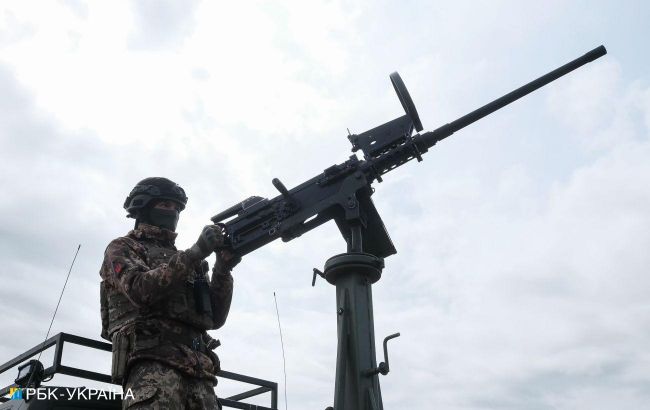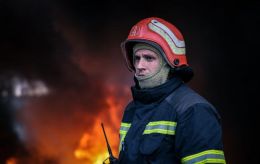Air raid alerts shake Ukraine: Reasons behind increased Russian activity
 Photo: Ukraine repels air attacks from Russia (Vitalii Nosach, RBC-Ukraine)
Photo: Ukraine repels air attacks from Russia (Vitalii Nosach, RBC-Ukraine)
Since last night, Russian aerial terror has hardly ceased. The enemy started by attacking Ukraine with Shahed drones, then launched cruise missiles from Tu-95MS bombers and ballistic missiles Kinzhals. Alarms sounded one after another throughout the day in Kyiv and across regions for various reasons.
Read more about Russia's objectives and the significance of Starokostiantyniv in the material by RBC-Ukraine below.
What is known about ongoing air alarms and their causes
This day for the Ukrainian air defense began with repelling the attack of Shahed-type kamikaze attack drones. The Russian forces launched them in groups from different directions, constantly regrouping. Interestingly, the target of the enemy UAVs again was Starokostiantyniv in the Khmelnytskyi region, which Russia has long "favored" due to the military airfield located there.
As the spokesperson of the Ukrainian Air Force, Illia Yevlash, explained, around 03:00 a.m., the enemy carried out the deployment of their strategic aviation from the Saratov region, namely Tu-95MS aircraft, and launched 10 cruise missiles. They entered Ukrainian airspace from the territory of the Sumy region, mostly heading westward. The Russian army classically aimed at the objects of critical and military infrastructure, Yevlash noted. Explosions were heard even in Zaporizhzhia. As it turned out, the reason for this was the attack of three Iskander-M ballistic missiles.
Around 6:00 a.m., the enemy launched an aeroballistic missile Kh-47M2 Kinzhal from the launch sites in the Tambov region. The target for the Russian forces again was Starokostiantyniv, but, as noted by the Air Force, the missile did not reach its target.
"The cruise missiles reached western Ukraine today, Kolomyia, then turned around and flew back towards Starokostiantyniv. Such techniques with the use of changing heights, happen from time to time. Each attack is unique in its own way," Yevlash said.
It is worth noting that during the night attack, the air defense forces managed to shoot down 7 out of 10 cruise missiles and all 17 drones.
But the work of the air defenders did not stop there. By morning, around 10:17 a.m., the Air Force warned of another missile launch heading towards the Khmelnytskyi region. However, later, residents of Kyiv heard explosions, indicating the work of air defense systems. But even then, air alerts did not end. The danger was also announced in several regions due to ballistic missiles, unidentified drones, and the takeoff of MiG-31K.
Expert names the probable enemy target
Military-political observer of the Information Resistance Group, Oleksandr Kovalenko, in a comment to RBC-Ukraine, pointed out that currently, the Russian forces have mainly concentrated their strikes in the area of Starokostiantyniv, specifically targeting the military airfield.
"And this is not the first time they are trying to strike on Starokostiantyniv. It's a regular occurrence. But now it has intensified. Most likely, the Russian forces believe that the Ukrainian Defense Forces will deploy the F-16 precisely at Starokostiantyniv. They are simultaneously trying to destroy the infrastructure there," Kovalenko believes.
In his opinion, this is why Russia is using the same Kh-47M2 Kinzhal missiles, which are expensive and very complex in production.
"Furthermore, they are directing other means of attack there, including Shahed and Kh-101/555. So, comprehensively, they are trying to maximize the destruction of infrastructure at Starokostiantyniv so that it's not prepared for the F-16," the expert says.
It's worth noting that the Russian forces launch both drones and missiles, and this is not their new tactic but rather quite a classical one.
"In fact, this is a fairly standard classical method. After strikes are carried out, reconnaissance is conducted. I would even say more. We could observe yesterday how four Kh-101/555 missiles were launched and they were shot down, as well as one Kinzhal, which was also destroyed (referring to the attack on June 12 - ed.). Then, by the way, there was battle reconnaissance," Kovalenko reminds.
According to him, during the previous attack using four Tu-95MS bombers, the enemy was assessing the situation with air defense systems in Ukraine, especially in the Kyiv region and near Kyiv.
"The Russian army was adjusting trajectories and flight routes in this way. They were preparing for this strike. Now they will likely follow a quite classical scheme, where strikes are conducted in a way that is difficult to intercept, followed by reconnaissance, then another strike, more reconnaissance, and so on," the expert adds.
It's worth reminding that during the previous combined air attack by the Russian Federation on Ukraine, Kyiv was also targeted. Read more about why the enemy decided to focus on the capital after a pause in material by RBC-Ukraine.
Sources: data from the Telegram channel of the Ukrainian Air Force, a statement from the spokesperson of the Air Force Command, Illia Yevlash, and an exclusive comment from the military-political observer of the Information Resistance group, Oleksandr Kovalenko.

